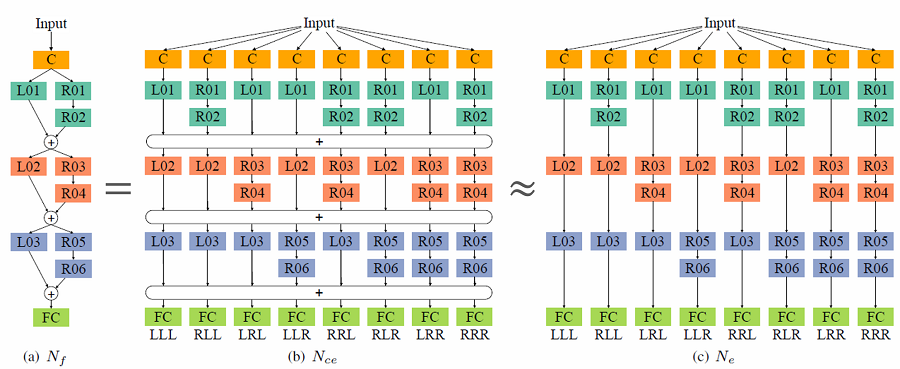zlmzju / Fusenet
Projects that are alternatives of or similar to Fusenet
Deep Fusion Project
This project contains the models used for the experiments in the paper:
Liming Zhao, Jingdong Wang, Xi Li, Zhuowen Tu, and Wenjun Zeng. "On the Connection of Deep Fusion to Ensembling." arXiv preprint arXiv:1611.07718 (2016).
Contact: Liming Zhao ([email protected])
Introduction
In this work, we provide a systematic study to the prevailing ResNet architecture by showing a connection from a general deeply-fused net view to ensembling.
Our empirical results uncover that the deepest network among the ensemble components does not contribute the most significantly to the overall performance and instead it provides a manner to introduce many layers and thus guarantee the ensemble size.
Guided by the above study and observation, we develop a new deeply-fused network that combines two networks in a merge-and-run fusion manner.
Our approach demonstrates consistent improvements over the ResNet with the comparable setup on CIFAR-10, CIFAR-100, SVHN, and ImageNet.
Results
- Test error (%) on CIFAR (flip/translation augmentation) and SVHN (no augmentation):
| Method | Depth | #Params | CIFAR-10 | CIFAR-100 | SVHN |
|---|---|---|---|---|---|
| DFN-MR1 | 56 | 1.7M | 4.94 | 24.46 | 1.66 |
| DFN-MR2 | 32 | 14.9M | 3.94 | 19.25 | 1.51 |
| DFN-MR3 | 50 | 24.8M | 3.57 | 19.00 | 1.55 |
- Training and validation error (%) on ImageNet:
| Method | Depth | #Params | Top-1 train | Top-5 train | Top-1 val | Top-5 val |
|---|---|---|---|---|---|---|
| ResNet | 98 | 45.0M | 15.09 | 3.25 | 23.38 | 6.79 |
| DFN-MR | 50 | 46.4M | 14.46 | 3.16 | 23.16 | 6.61 |
Requirements
-
Install MXNet on a machine (Windows, Linux, and Mac OS) with CUDA GPU and optional cuDNN.
-
Apply my modified data processing patch on the latest MXNet by merging the pull request:
git pull origin pull/3936/head master
-
(Recommended) If you fail to apply the above patch, you can simply use my MXNet repository:
git clone --recursive -b fusenet https://github.com/zlmzju/mxnet.git
How to Train
Step by step tutorial with jupyter notebook is now available, please check the file tutorial.ipynb.
dataset
You can prepare the *.rec file by yourself, or simply download the Cifar dataset from data.dmlc.ml or my google drive (recommended), which includes both Cifar and SVHN datasets.
For ImageNet dataset, follow the mxnet official document
to prepare.
training
Current code supports training different deeply-fused nets on Cifar-10, Cifar-100, SVHN and ImageNet, such as plain network, resnet, cross (dfn-mr),half (dfn-il), side (dfn-il without identities), fuse3 (three fusions), fuse6 (six fusions), and ensemble (with sharing weights, training code will come later). All the networks are contained in the network folder.
For example, running the following command can train the DFN-MR network (we call it cross in the coding stage) on Cifar-10.
python train_model.py --dataset=cifar10 --network=cross --depth=56 --gpus=0,1 --dataset=<dataset location>
To train DFN-MR network on ImageNet, run
python train_imagenet.py --network=symbol_cross --gpus=0,1,2,3 --data-dir=<dataset location>
Other usages
visualization
If you want to show the network architecture, run the following command to visualize the network.
python show_model.py --network=half --depth=26 --widen-factor=1
You will obtain a picture half_d26.png in the visualize folder, and more examples can be found there.
Note that you may need to install graphviz for visualization.
show results
The training log are saved to snapshot folder, and you can use get_results.py to obtain the final result of multiple runs in the format of median (mean +/- std, best).
Citation
Please cite our papers on deep fusion in your publications if it helps your research:
@article{WangWZZ16,
author = {Jingdong Wang and
Zhen Wei and
Ting Zhang and
Wenjun Zeng},
title = {Deeply-Fused Nets},
journal = {CoRR},
volume = {abs/1605.07716},
year = {2016},
url = {http://arxiv.org/abs/1605.07716},
}
@article{ZhaoWLTZ16,
author = {Liming Zhao and
Jingdong Wang and
Xi Li and
Zhuowen Tu and
Wenjun Zeng},
title = {On the Connection of Deep Fusion to Ensembling},
journal = {CoRR},
volume = {abs/1611.07718},
year = {2016},
url = {http://arxiv.org/abs/1611.07718},
}


